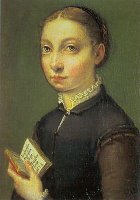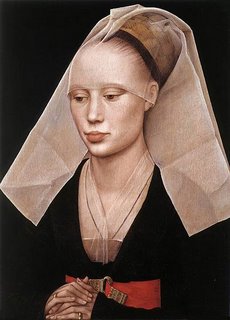
Devorah Sperber, After Van Eyck
5,024 spools of thread, stainless steel ball chain and hanging apparatus, clear acrylic viewing sphere and metal stand; 104 x 100 x 60"
.
At the 212 Fair this past weekend, I spent time at the Marcia Wood Gallery booth which showed some of my Silk Road paintings. The hit of the booth was the wall-size installation by Devorah Sperber, who creates large-scale pixilated portraits. The "pixels" are spools of thread suspended in vertical rows with the wall as a backdrop. The image is so diffuse because of its scale and inverted orientation (and your proximity to it) that it doesn’t register visually until you peer into a small acrylic sphere centered about 5 feet in front of the installation. The sphere is perfectly aligned with the central eye of the portrait, which is perfectly aligned with the central axis of the work. There a clear and beautifully nuanced right-side-up portrait appears.I mention the centered-eye portraits—that is, three-quarter-view portraits in which one of the eyes falls at the central axis of the portrait --because after spending part of the weekend looking at portraits, indeed it appears to be true. Another thing you never learned in art school. A recent study of the portraits of 282 artists--drawn from diverse cultures over five centuries--finds that the eye is central to the vertical axis of a painting to within an eye width in virtually every instance. You can read the study for yourself: http://www.ski.org/cwt/CWTyler/PrePublications/ARVO/1998/Portraits/ and http://www.ski.org/cwt/CWTyler/PrePublications/ARVO/1998/Portraits/
On her website, Sperber talks about both the physiology of seeing and the theory of centered-eye portraits. You can see more of her brilliantly conceived and beautifully executed work there as well. I've posted a few examples here:

Michelangelo Self Portrait; Sofonisba Anguissola Self Portrait, 1554; Tiziano's portrait of Cardinale Pietro Bembo, 1540

Rogier van der Weyden, Portrait of a Lady, 1554
There's also Leonardo's Mona Lisa, Vermeer's Girl with a Pearl Earring, and many of the Fayums. On Friday, while visiting the Met’s early Renaissance paintings with my friend, the painter Kay WalkingStick, I mentioned this centered-eye theory, and as we looked, portrait after portrait followed this form. Perhaps it is simply a visually intuitive way of creating an image that looks you in the eye, whether or not the sitter is actually looking back at you, satisfying a human need for equilibrium and harmony.
Or perhaps it was a trade secret passed along from painter to painter. Talk about a Da Vinci code: "Sfumato schfumato, Leonardo. The secret to making a haunting portrait is to make sure one of her eyes aligns directly with the central axis of the portrait. Pass it along."

Leonardo Da Vinci, Mona Lisa, 1505
Even Picasso, who broke with the conventions of painting, didn't stray far from this one:

Picasso, Weeping Woman, 1937















No comments:
Post a Comment